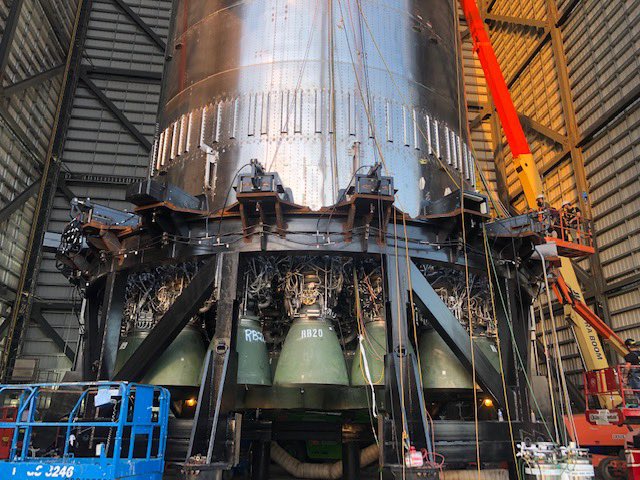"This, by the way, is very high on their top risk list."
A senior NASA official said this week that SpaceX has done "very well" in working toward the development of a vehicle to land humans on the surface of the Moon, taking steps to address two of the space agency's biggest concerns.
NASA selected SpaceX and Starship for its Human Landing System in April 2021. In some ways, this was the riskiest choice of NASA's options because Starship is a very large and technically advanced vehicle. However, because of the company's self-investment of billions of dollars into the project, SpaceX submitted the lowest bid, and from its previous work with SpaceX, NASA had confidence that the company would ultimately deliver.
Two of NASA's biggest technological development concerns were the new Raptor rocket engine and the transfer and storage of liquid oxygen and methane propellant in orbit, said Mark Kirasich, NASA's deputy associate administrator who oversees the development of Artemis missions to the Moon. During a subcommittee meeting of NASA's Advisory Council on Monday, however, Kirasich said SpaceX has made substantial progress in both areas.
On Raptor
The Raptor rocket engine is crucial to Starship's success.
Thirty-three of these Raptor 2 engines power the Super Heavy booster that serves as the vehicle's first stage, and six more are used by the Starship upper stage.
For a successful lunar mission, these engines will need to re-light successfully on the surface of the Moon to carry astronauts back to orbit inside Starship.
"SpaceX has moved very quickly on development," Kirasich said about Raptor. "We've seen them manufacture what was called Raptor 1.0.
They have since upgraded to Raptor 2.0 that first of all increases performance and thrust and secondly reduces the amount of parts, reducing the amount of time to manufacture and test.
They build these things very fast.
Their goal was seven engines a week, and they hit that about a quarter ago.
So they are now building seven engines a week."
To put this into perspective, the Raptor 2 rocket engine produces approximately 510,000 pounds of thrust.
This is almost identical to the amount of thrust produced by the RS-25 engine that will be used to power NASA's Space Launch System rocket.
This engine was designed and developed by Rocketdyne in the 1970s for the space shuttle program, and the company has decades of experience manufacturing them.
In 2015, NASA gave Aerojet Rocketdyne a contract worth $1.16 billion to "restart the production line" for the RS-25 engine.
Again, that was money just to reestablish manufacturing facilities, not actually build the engines.
NASA is paying more than $100 million for each of those.
With this startup funding, the goal was for Aerojet Rocketdyne to produce four of these engines per year.
Kirasich said that as it builds and tests Raptors, SpaceX is rapidly iterating on these processes and producing higher-quality engines.
Fuel depots
SpaceX is also working toward demonstrations of the storage and transfer of cryogenic propellants in space—the liquid oxygen and methane used by Starship to fly to and land on other worlds.
"This, by the way, is very high on their top risk list," Kirasich said of cryogenic fuel management.
"There is a thorough ground test program and, more importantly, a thorough in-space propellant transfer and also measurement of boil off in space test plan."
During Artemis Moon missions, SpaceX will launch the lunar lander version of its Starship into low-Earth orbit, where it will rendezvous with a depot.
This propellant depot will be optimized to prevent the "boil off" of cryogenic fuels in space. (Yes, space is very cold, but when exposed to sunlight, objects in space can get very hot regardless.)
SpaceX plans to load this depot with propellant prior to the launch of a lunar Starship with a "tanker" form of the vehicle. Kirasich was not specific but said it would require "relatively speaking, quite a few" tanker flights to provide enough fuel for a Starship-to-the-Moon mission.
Kirasich said SpaceX is presently targeting early December for a test flight of Starship and Super Heavy, although this timeline is dependent upon a number of factors, including a full 33-engine static fire test of Super Heavy, an FAA launch license, and final preparation of ground systems at SpaceX's Starbase launch facility in South Texas.
After this initial test flight, Kirasich said NASA is tracking three additional flight tests of Starship for fueling demonstrations.
The second test, Kirasich said, will entail a tank-to-tank transfer of propellant, followed by a Starship-to-Starship transfer of propellant, to a complete fueling of Starship from a depot and a long-duration flight to mimic the in-space time of a lunar mission.
SpaceX plans to keep its low-Earth orbit propellant depots topped off with fuel for missions other than Artemis, Kirasich added.
"So it's not like every time we go to the Moon we're going to start with an empty depot," he said.
Depending on how well SpaceX's in-flight demonstrations go, Kirasich said the nominal target for an uncrewed test flight of Starship to the surface of the Moon—and back up to orbit around the Moon—is toward the end of 2024.
If this is successful, it would set the stage for the Artemis III mission, carrying NASA astronauts down to the Moon.
Source

